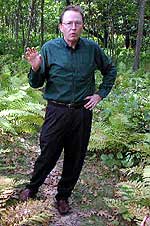By Marisa Helms
Minnesota Public Radio
September 20, 2002
One of the University of Minnesota's unique research centers, the Cedar Creek Natural History Area, is celebrating its 60th anniversary. Cedar Creek, located along the border of Anoka and Isanti counties, is special for researchers because three different ecosystems converge there, making it an ideal place to study how natural systems co-exist.
| |
|
|
|
||
As Cedar Creek Director David Tilman heads down a trail toward Cedar Bog Lake, he points out to a visitor how the landscape can change in just a few paces.
"If you look out that way you see a different kind of vegetation," Tilman points out.
There's old agricultural land that's been turning back into prairie for the past 70 years. That turns into a cedar forest, which becomes a maple basswood forest that leads finally to Cedar Bog Lake.
Tilman says this small but diverse section of Cedar Creek is a perfect place to measure and compare past and future ecosystems.
"We can look at Cedar Creek as part of a mosaic of landscapes throughout this region, and ask, 'What happens in maple forests, what happens in cedar swamps, what happens in prairie grasslands?'" says Tilman. "We can go out and ask, 'What happens on farmfields, what happens throughout this whole region?' And we can find out the benefits that society receives from these different ecosystems."
| |
|
|
|
||
Tilman's work at Cedar Creek focuses on threats to biodiversity. As part of one major experiment in 1994, Tilman and his team created 342 small patches of land on 20 acres. They then randomly planted one to 16 plant species within those plots. Plants did better in plots with multiple species.
Tilman says his research shows that biodiversity matters, and that the loss of species threatens the sustainability of ecosystems.
Tilman says his experiment is part of a larger goal of looking at the significant influence, and potential threat, that humans bring to their natural environment.
"One thing we're doing is decreasing the biological diversity of the world. We're doing that by driving species extinct. And that's a horrible thing to have happen. It's irreversible," says Tilman.
Another major experiment at Cedar Creek is looking into the effect of increased carbon dioxide on ecosystems and biodiversity.
|
"We can look at Cedar Creek as part of a mosaic of landscapes throughout this region ... and we can find out the benefits that society receives from these different ecosystems."
- David Tilman, Cedar Creek director |
Six 100-foot rings encircle small plots of plant species. Enclosing the rings are pipes. Pipes around three of the rings spew carbon dioxide, while species in the other three rings are given oxygen.
Tilman says this controlled experiment allows researchers to see the effects of carbon dioxide 50 years into the future.
"Because of the burning of fossil fuels associated with the industrial revolution, carbon dioxide in the atmosphere has gone up from 260 parts per million to a current level of about 370 million. It is thought by the year 2050, it will be double what they were before the industrial revolution," Tilman says. "This is a time machine. We're seeing what happens to ecosystems if we make them have carbon dioxide levels like what we expect to see in the year 2050."
Tilman says the research findings will be published, and discussed with economists and policy makers.
In the 1960s and '70s, Cedar Creek was considered the place to be for tracking wildlife. Scientists at Cedar Creek pioneered that practice as well as the process of controlled burns for forests.
More Information

